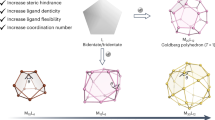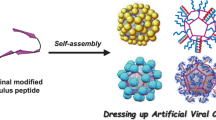Abstract
Self-assembled cage structures of nanometre dimensions can be used as constrained environments for the preparation of nanostructured materials1,2 and the encapsulation of guest molecules3, with potential applications in drug delivery4 and catalysis5. In synthetic systems the number of subunits contributing to cage structures is typically rather small3,6. But the protein coats of viruses (virions) commonly comprise hundreds of subunits that self-assemble into a cage for transporting viral nucleic acids. Many virions, moreover, can undergo reversible structural changes that open or close gated pores to allow switchable access to their interior7. Here we show that such a virion — that of the cowpea chlorotic mottle virus — can be used as a host for the synthesis of materials. We report the mineralization of two polyoxometalate species (paratungstate and decavanadate) and the encapsulation of an anionic polymer inside this virion, controlled by pH-dependent gating of the virion's pores. The diversity in size and shape of such virus particles make this a versatile strategy for materials synthesis and molecular entrapment.
This is a preview of subscription content, access via your institution
Access options
Subscribe to this journal
Receive 51 print issues and online access
$199.00 per year
only $3.90 per issue
Buy this article
- Purchase on Springer Link
- Instant access to full article PDF
Prices may be subject to local taxes which are calculated during checkout





Similar content being viewed by others
References
Mann, S. Biomimetic Materials Chemistry (VCH, New York, 1996).
Stucky, G. D. & MacDougall, J. E. Quantum confinement and host/guest chemistry: Probing a new dimension. Science 247, 669–678 (1990).
Rebek, J. J. Assembly and encapsulation with self complementary molecules. Chem. Soc. Rev. 25, 255–264 (1996).
Park, K. Controlled Drug Delivery: Challenges and Strategies (Am. Chem. Soc., Washington DC, 1997).
Kang, J. & Rebek, J. J. Acceleration of a Diels-Alder reaction by a self-assembled molecular capsule. Nature 385, 50–52 (1997).
MacGillivray, L. R. & Atwood, J. L. Achiral spherical molecular assembly held together by 60 hydrogen bonds. Nature 389, 469–472 (1997).
Speir, J. A., Munshi, S., Wang, G., Baker, T. S. & Johnson, J. E. Structures of the native and swollen forms of cowpea chlorotic mottle virus determined by X-ray crystallography and cryo-electron microscopy. Structure 3, 63–78 (1995).
Zhao, X., Fox, J. M., Olson, N. H., Baker, T. S. & Young, M. J. In vitro assembly of cowpea chlorotic mottle virus from coat protein expressed in Escherichia coli and in vitro-transcribed viral cDNA. Virology 207, 486–494 (1995).
van der Graaf, M., van Mierlo, C. P. M. & Hemminga, M. A. Solution conformation of a peptide fragment representing a proposed RNA-binding site of a viral coat protein studied by two-dimensional NMR. Biochemistry 30, 5722–5727 (1991).
Misono, M. in Polyoxometalates: From Platonic Solids to Anti-Retroviral Activity (eds Pope, M. T. & Müller, A.) 255–266 (Kluwer Academic, Dordrecht, 1994).
Sarafianos, S. G., Kortz, U., Pope, M. T. & Modak, M. J. Mechanism of polyoxometalate-mediated inactivation of DNA polymerases: an analysis with HIV-1 reverse transcriptase indicates specificity for the DNA-binding cleft. Biochem. J. 319, 619–626 (1996).
Belford, D. A., Hendry, I. A. & Parish, C. R. Investigation of the ability of several naturally occurring and synthetic polyanions to bind to and potentiate the biological activity of acidic fibroblast growth factor. J. Cell Physiol. 157, 184–189 (1993).
Meldrum, F. C., Wade, V. J., Nimmo, D. L., Heywood, B. R. & Mann, S. Synthesis of inorganic nanophase materials in supramolecular protein cages. Nature 349, 684–687 (1991).
Meldrum, F. C., Heywood, B. R. & Mann, S. Magnetoferritin: In vitro synthesis of a novel magnetic protein. Science 257, 522–523 (1992).
Douglas, T. in Biomimetic Approaches in Materials Science (ed. Mann, S.) 91–115 (VCH, New York, 1996).
Johnson, J. E. & Speir, J. Quasi-equivalent viruses: A paradigm for protein assemblies. J. Mol. Biol. 269, 665–675 (1997).
Chiu, W., Burnett, R. & Garcea, R. Structural Biology of Viruses (Oxford Univ. Press, 1997).
Hogle, J. M., Chow, M. & Filman, D. J. Three-dimensional structure of poliovirus at 2.9 Å resolution. Science 229, 1358–1365 (1985).
Namba, K., Pattanayek, R. & Stubbs, G. Visualization of protein-nucleic acid interactions in a virus; Refinement of intact tobacco mosaic virus structure at 2.9 Å resolution by fiber diffraction. J. Mol. Biol. 208, 307–325 (1989).
Bancroft, J. B., Wagner, G. W. & Bracket, C. E. The self-assembly of a nucleic-acid free pseudo-top component for a small spherical virus. Virology 36, 146–149 (1968).
Houk, K. N., Nakamura, K., Sheu, C. & Keating, A. E. Gating as a control element in constrictive binding and guest release by hemicarcerands. Science 273, 627–629 (1996).
Pope, M. T. Heteropoly and Isopoly Oxometalates (Springer, Heidelberg, 1983).
Evans, H. T. & Prince, E. Location of internal hydrogen atoms in the paradocecatungstate polyanion by neutron diffraction. J. Am. Chem. Soc. 105, 4838–4839 (1983).
d'Amour, H. & Allman, R. Die kristallstruktur des dinatrium-oktammonium-parawolframat-dodekahydrats, Na2(NH4)8[H2W12O42]·12H2O. Z. Kristallogr. 138, 5–18 (1972).
Powder Diffraction File 20-1176(Joint Committee on Powder Diffraction Standards, Swarthmore, PA).
Johnson, G. K. & Murmann, R. K. Sodium and ammonium decavanadates (V). Inorg. Synth. 19, 140–145 (1979).
Heywood, B. R. & Mann, S. Template directed nucleation and growth of inorganic materials. Adv. Mater. 6, 9–20 (1994).
Sherman, J. C. & Cram, D. J. Carcerand interiors provide a new phase of matter. J. Am. Chem. Soc. 111, 4527–4528 (1989).
Lawson, D. M.et al. Solving the structure of human H ferritin by genetically engineering intermolecular crystal contacts. Nature 349, 541–544 (1991).
Smith, A. E. Viral vectors in gene therapy. Annu. Rev. Microbiol. 49, 807–838 (1995).
Fox, J. M., Zhao, X., Speir, J. A. & Young, M. J. Analysis of a salt stable mutant of cowpea chlorotic mottle virus. Virology 222, 115–122 (1996).
Acknowledgements
We thank S. Brumfield, D. Mogk and G. Myer for experimental assistance, and R.Lakis for assistance with the electron microscopy.
Author information
Authors and Affiliations
Corresponding authors
Rights and permissions
About this article
Cite this article
Douglas, T., Young, M. Host–guest encapsulation of materials by assembled virus protein cages. Nature 393, 152–155 (1998). https://doi.org/10.1038/30211
Received:
Accepted:
Issue Date:
DOI: https://doi.org/10.1038/30211
This article is cited by
-
The development progress of multi-array colourimetric sensors based on the M13 bacteriophage
Nano Convergence (2023)
-
DNA-origami-directed virus capsid polymorphism
Nature Nanotechnology (2023)
-
Re-exploring silver nanoparticles and its potential applications
Nanotechnology for Environmental Engineering (2023)
-
Nanoreactors for particle synthesis
Nature Reviews Materials (2022)
-
Asymmetrizing an icosahedral virus capsid by hierarchical assembly of subunits with designed asymmetry
Nature Communications (2021)
Comments
By submitting a comment you agree to abide by our Terms and Community Guidelines. If you find something abusive or that does not comply with our terms or guidelines please flag it as inappropriate.



